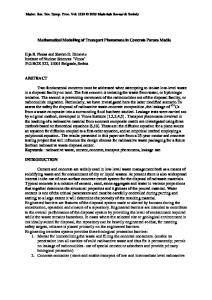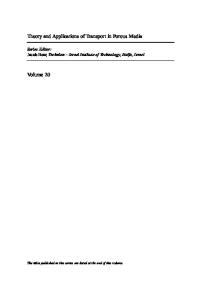An Extended Thermodynamic Approach to Transport Phenomena in Porous Media
- PDF / 360,494 Bytes
- 6 Pages / 420.48 x 639 pts Page_size
- 62 Downloads / 377 Views
AN
EXTENDED
THERMODYNAMIC
APPROACH TO POROUS MEDIA*
TRANSPORT
PHENOMENA
IN
00
J. A. del Rio and M. L6pez de Haro Laboratorio de Energia Solar. IIM-UNAM. A.P. 34. 62580, Temixco, Mor. Mexico
Zona Cultural Xochicalco,
Abstract A formalism of extended irreversible thermodynamics (EIT) is used to study the physical aspects of heat, momentum and mass transport through porous media. The thermodynamic space is enlarged with respect to that of classical linear irreversible thermodynamics (LIT) to include the mass, heat and momentum fluxes as independent variables. The time evolution equations for such variables are derived self-consistently and reduce to the usual constitutive equat,ions of LIT when the appropriate limits are taken. Equations that involve effects characterized by terms of second order in the gradients of conserved variables (such as the Darcy-Brinkman law) may also be derived within the same formalism. Finally, EIT provides the natural framework beyond LIT to introduce non-isothermal effects in the study of transport phenomena in porous media. I.
INTRODUCTION
In the last thirty years, much progress has been made in the fundamental developments and the experimental verifications of the thermodynamic theory of irreversible processes, also known as linear irreversible thermodynamics (LIT). A nice account of this theory, whose statistical mechanical foundations rest mainly on the work by Onsager , may be found in the monograph by de Groot and Mazur . The most significant feature of LIT is the explanation of the occurrence of cross phenomena. According to this theory, linear thermodynamic couplings may exist in any system where two or more thermodynamic forces of the same tensorial character are present. Notwithstanding the merits of LIT, it is well known that it presents some limitations. One of the first physical objections that was raised against it was the fact that the differential equations describing the propagation of disturbances in the system predict an infinite velocity of transmission. Moreover, the linear character of this theory imposes restrictions on the nonequilibrium states that may be dealt with. Thus, it is not surprising that many efforts have recently been devoted to generalize LIT to overcome the aforementioned limitations. Among these efforts, the ones generically referred to as extended irreversible thermodynamics (EIT) 3' 4 have achieved some success in removing a few of the restrictions embodied in LIT. A large body of literature exists applying the ideas of LIT to porous media. We have for instance the statistical mechanical approachs' , the phenomenological approach7 '8.9 and experimental verifications of the Onsager reciprocal relations 1 The aim of this paper is to illustrate the description of transport phenomena in porous media within EIT. In particular, we will derive a generalization of the Darcy-Brinkman law that allows the
Mat. Res. Soc. Symp. Proc. Vol. 195. 01990 Materials Research Society
284
consideration of nonisothermal phenomena. The paper is organized
Data Loading...











